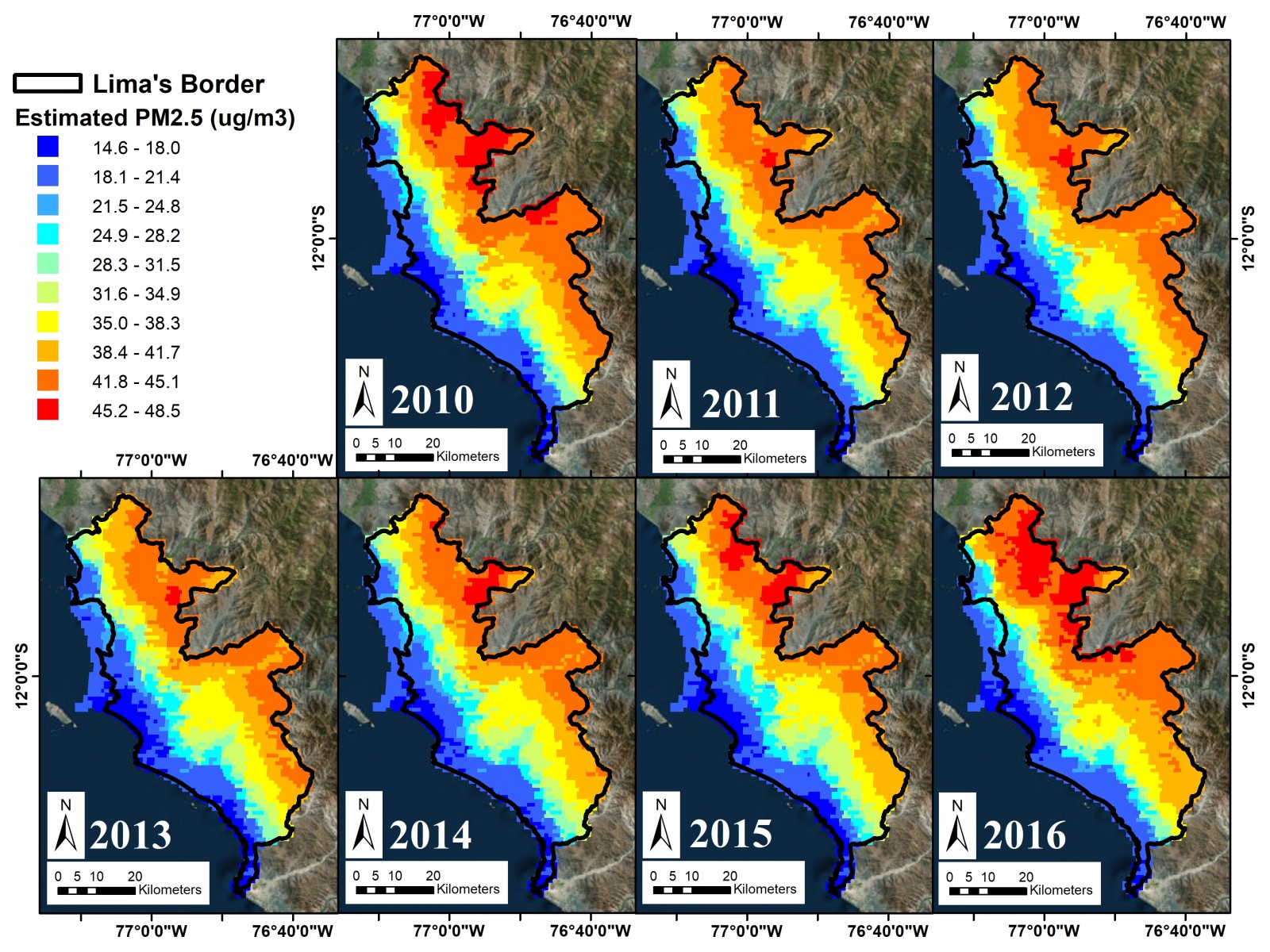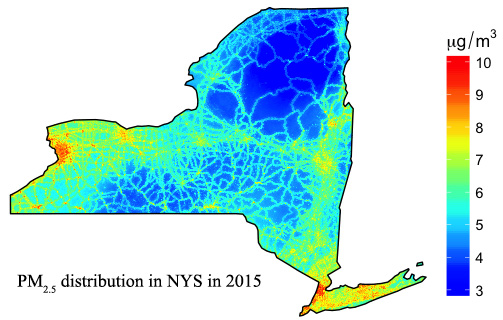In this publication, we pioneer methods for separating smoke PM2.5 from ambient PM2.5 concentrations. We used case-crossover methods to look at the potential health effects from smoke PM2.5 exposure. Our approach differs from previous literature in that we isolate the PM2.5 from smoke alone. Historically, this has mostly been done using total PM2.5 concentrations with a fire indicator variable. Our results suggest that there could be a difference in toxicological effect from smoke PM2.5 exposure compared with ambient PM. Hence, while following similar trends seen in other publications, we obtained greater health effects for smoke PM2.5 concentrations. This work can be built upon to help understand the burden of smoke exposure in the context of climate change.
Category: Papers
Murray et al.: new method on PM2.5 Bayesian Ensemble Models
We develop a method to combine PM2.5 estimated from satellite-retrieved aerosol optical depth (AOD) and chemical transport model (CTM) simulations using statistical models. While most previous methods utilize AOD or CTM separately, we aim to leverage advantages offered by both data sources in terms of resolution and coverage using Bayesian ensemble averaging. Our approach differs from previous ensemble approaches in its ability to not only incorporate uncertainties in PM2.5 estimates from individual models but also to provide uncertainties for the resulting ensemble estimates. In an application of estimating daily PM2.5 in the Southeastern US, the ensemble approach outperforms previously developed spatial-temporal statistical models that use either AOD or bias-corrected CTM simulations in cross-validation (CV) analyses.
Zhou et al.: Compilation and spatio-temporal analysis of publicly available total solar and UV irradiance data in the United States
Skin cancer is the most common type of cancer in the United States, the majority of which is caused by overexposure to ultraviolet (UV) irradiance, which is one component of sunlight. Our group worked with University of Iowa and the National Environmental Public Health Tracking Program at CDC to develop and disseminate county-level daily UV irradiance (2005 – 2015) and total solar irradiance (1991 – 2012) data for the contiguous United States (See intro on CDD Tracking webiste). These datasets are freely available at the CDC Tracking Portal. Trend analysis also showed that national annual average daily solar and UV irradiances increased significantly over the years by about 0.3% and 0.5% per year, respectively. These datasets can help us understand the spatial distributions and temporal trends of solar and UV irradiances, and allow for improved characterization of UV and sunlight exposure in future studies.
The Full publication link is here.
Vu et al.: Developing an Advanced PM2.5 Exposure Model in Lima, Peru
We developed a machine learning model to estimate daily PM2.5 levels in Lima Peru. This is the first advanced model to incorporate satellite remote sensing data as well as variables from chemical transport and forecast models to predict daily PM2.5 levels in South America. Our results indicates that concentrations are low in the coast and rises with elevation up to the Andes Mountains due to prevailing coastal winds. This model also provides historical daily levels for epidemiological studies in a rapidly developing urban center.

Vu, B.N.; Sánchez, O.; Bi, J.; Xiao, Q.; Hansel, N.N.; Checkley, W.; Gonzales, G.F.; Steenland, K.; Liu, Y. Developing an Advanced PM2.5 Exposure Model in Lima, Peru. Remote Sens. 2019, 11, 641. https://doi.org/10.3390/rs11060641
Bi et al. Impacts of snow and cloud covers on satellite-derived PM2.5 levels
We developed an AOD gap-filling model with the consideration of snow and cloud covers and a PM2.5 prediction model based on the gap-filled AOD to estimate full-coverage and high-resolution PM2.5 in New York State. It indicated the significance of snow fraction in the AOD gap-filling process and demonstrated the ability of the AOD-based prediction model to reflect detailed PM2.5 emission patterns and small-scale terrain-driven features.

Bi, J., Belle, J. H., Wang, Y., Lyapustin, A. I., Wildani, A., & Liu, Y. (2019). Impacts of snow and cloud covers on satellite-derived PM2.5 levels. Remote Sensing of Environment, 221, 665–674. https://doi.org/10.1016/j.rse.2018.12.002
Meng et al. Space-time trends of PM2.5 constituents in the Conterminous United States estimated by a machine learning approach, 2005-2015
We developed national machine-learning models to provide interpretable results, to predict concentrations of PM2.5 sulfate, nitrate, organic carbon (OC) and elemental carbon (EC) across the conterminous United States from 2005 to 2015 at the daily level.
Xiao et al: An ensemble machine-learning model to predict historical PM2.5 concentrations in China from satellite data
We developed a machine learning approach to estimate historical PM2.5 levels in China. It overcame several previous issues related to satellite-based PM2.5 exposure estimates such as data missingness due to cloud cover, model stability across a large spatial domain, and robust hindcasting capability beyond the model fitting period.
Geng et al. The sensitivity of satellite-based PM2.5 estimates to its inputs: implications to model development in data-poor regions
We conducted comprehensive sensitivity model simulations to investigate the key factors that could affect the performance of satellite-based PM2.5 exposure in data-poor regions including temporal sampling frequency, number of ground monitors, accuracy of the chemical transport model simulation, and different combinations of the additional predictors.
Wang et al.: A Bayesian Downscaler Model to Estimate Daily PM2.5 levels in the Continental U.S
We proposed a statistically reliable and interpretable national modeling framework based on Bayesian downscaling methods to be applied to the calibration of the daily ground PM2.5 concentrations across the conterminous United States using satellite-retrieved aerosol optical depth (AOD) and other ancillary predictors